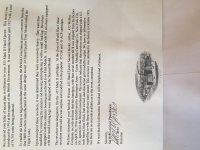Hair Trigger
US Veteran
I received my letter from the S&W Historical Foundation today, that I requested on my Model 29 NCHP 50th Anniversary Commemorative. I must say, I'm disappointed in the information included in the letter, most of which had nothing to do with my particular revolver. The first paragraph was a quick history of the first police commemorative, for the Texas Ranger 150th Anniversary. The second paragraph told about other police commemoratives and specified the Ohio State Patrol, and how police commemoratives became popular.
The information on my specific revolver is very basic, and I've learned more about it from the Standard Catalog and general S&W forum members than was included in the letter, some of which is incorrect and/or incomplete. For instance, the letter states the NCHP "logo" which is actually the Trooper's Shield, is, and I quote "stamped" on the side plate, along with the anniversary markings on the barrel. Just to look at the markings, one can tell they are not stamped, but etched, and I have learned they were acid etched at that. I did get a specific number of how many revolvers were purchased for the series, and the shipping date of my revolver. There is no information on the rarity or collector value, which I had hoped there would be at least an estimate based on ANIB condition and unfired. I had also hoped for some statement regarding the process used to etch my revolver and those others in the series, and why that process was chosen over roll stamping, which it seems the majority, if not all other commemoratives used.
I can only hope that this letter, when included with the revolver and presentation case, will increase the value of the package by $100 if it is ever sold.
The information on my specific revolver is very basic, and I've learned more about it from the Standard Catalog and general S&W forum members than was included in the letter, some of which is incorrect and/or incomplete. For instance, the letter states the NCHP "logo" which is actually the Trooper's Shield, is, and I quote "stamped" on the side plate, along with the anniversary markings on the barrel. Just to look at the markings, one can tell they are not stamped, but etched, and I have learned they were acid etched at that. I did get a specific number of how many revolvers were purchased for the series, and the shipping date of my revolver. There is no information on the rarity or collector value, which I had hoped there would be at least an estimate based on ANIB condition and unfired. I had also hoped for some statement regarding the process used to etch my revolver and those others in the series, and why that process was chosen over roll stamping, which it seems the majority, if not all other commemoratives used.
I can only hope that this letter, when included with the revolver and presentation case, will increase the value of the package by $100 if it is ever sold.




